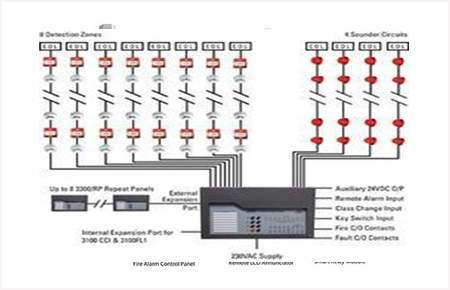Conventional Fire Alarm System
A conventional fire alarm control panels have been around ever since electronics became small enough to make them viable. Conventional panels are used less frequently in large buildings than in the past, but are not uncommon on smaller projects such as small schools, stores, restaurants, and apartments.
A conventional fire alarm control panel employs one or more circuits, connected to initiating devices wired in parallel. These sensors are devised to dramatically decrease the circuit resistance when the environmental influence on any sensor exceeds a predetermined threshold. In a conventional fire alarm system, the information density is limited to the number of such circuits used.
To facilitate location and control of fire within a building, the structure is subdivided into definite areas or zones. Floors of a multistory building are one type of zone boundary.
An Initiating Device Circuit (known as a Signaling Line Circuit (SLC) in addressable systems) connected to multiple devices within the same "zone" of protection, effectively provides 3 bits of information about the zone to the panel; normal, trouble, and alarm. The state of each initiating device circuit within a zone displays at the fire alarm control panel using visible indications, such as a flashing LED/light or an LCD display.
The panel may employ a graphical representation of the zone boundaries on a floor plan (zone map) using textual descriptions, illuminated icons, illuminated sections, or illuminated points on the map corresponding to initiating circuits connected to the fire alarm control panel.
Larger systems and increasing demand for finer diagnostic detail beyond broad area location and control functions expanded the control by zone strategy of conventional systems by providing multiple initiating circuits within a common zone, each exclusively connected to a particular type of initiating device, or group of devices. This arrangement forms a device type by zone matrix whose information is particularly suited to the Tabular annunciator In multistorey buildings employing a Tabular annunciator, for example; rows of indicators define the floors horizontally in their stacked relationship and the type of device installed on that floor displays as columns of indicators vertically aligned through each floor. The intersection of the floor and device indicators provides the combined information. The density of information however remains a function of the number of circuits employed.
Even larger systems and demands for finer diagnostic and location detail led to the introduction of addressable fire alarm systems, with each addressable device providing specific information about its state while sharing a common communication circuit. Annunciation and location strategies for the most part remain relatively unchanged.
More and more organisations recognise the value of CCTV as an everyday aid to:
- Quickly determine the location of a fire.
- Specific actions can be programmed by the user.
- Reduced likelihood and better handling of false alarms.
- More reliability, less likely to lose connection.
- Lower overall cost of wiring.
- Ability to monitor integrity of the system, with detector health checks.

